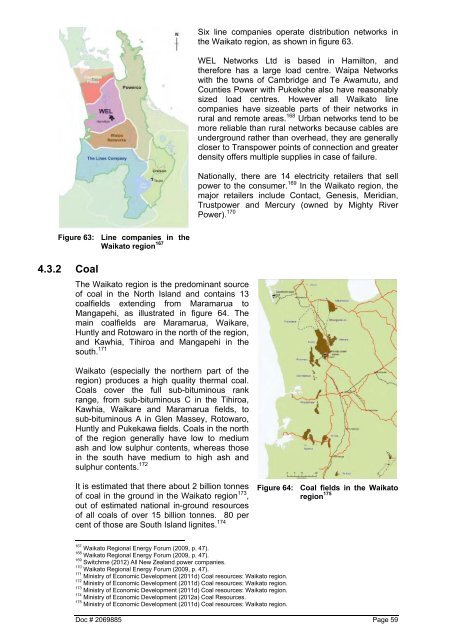Waikato regional economic profile - Waikato Regional Council
Waikato regional economic profile - Waikato Regional Council
Waikato regional economic profile - Waikato Regional Council
- No tags were found...
Create successful ePaper yourself
Turn your PDF publications into a flip-book with our unique Google optimized e-Paper software.
Six line companies operate distribution networks inthe <strong>Waikato</strong> region, as shown in figure 63.WEL Networks Ltd is based in Hamilton, andtherefore has a large load centre. Waipa Networkswith the towns of Cambridge and Te Awamutu, andCounties Power with Pukekohe also have reasonablysized load centres. However all <strong>Waikato</strong> linecompanies have sizeable parts of their networks inrural and remote areas. 168 Urban networks tend to bemore reliable than rural networks because cables areunderground rather than overhead, they are generallycloser to Transpower points of connection and greaterdensity offers multiple supplies in case of failure.Nationally, there are 14 electricity retailers that sellpower to the consumer. 169 In the <strong>Waikato</strong> region, themajor retailers include Contact, Genesis, Meridian,Trustpower and Mercury (owned by Mighty RiverPower). 170Figure 63: Line companies in the<strong>Waikato</strong> region 1674.3.2 CoalThe <strong>Waikato</strong> region is the predominant sourceof coal in the North Island and contains 13coalfields extending from Maramarua toMangapehi, as illustrated in figure 64. Themain coalfields are Maramarua, Waikare,Huntly and Rotowaro in the north of the region,and Kawhia, Tihiroa and Mangapehi in thesouth. 171<strong>Waikato</strong> (especially the northern part of theregion) produces a high quality thermal coal.Coals cover the full sub-bituminous rankrange, from sub-bituminous C in the Tihiroa,Kawhia, Waikare and Maramarua fields, tosub-bituminous A in Glen Massey, Rotowaro,Huntly and Pukekawa fields. Coals in the northof the region generally have low to mediumash and low sulphur contents, whereas thosein the south have medium to high ash andsulphur contents. 172It is estimated that there about 2 billion tonnesof coal in the ground in the <strong>Waikato</strong> region 173 ,out of estimated national in-ground resourcesof all coals of over 15 billion tonnes. 80 percent of those are South Island lignites. 174Figure 64: Coal fields in the <strong>Waikato</strong>region 175167<strong>Waikato</strong> <strong>Regional</strong> Energy Forum (2009, p. 47).168<strong>Waikato</strong> <strong>Regional</strong> Energy Forum (2009, p. 47).169Switchme (2012) All New Zealand power companies.170<strong>Waikato</strong> <strong>Regional</strong> Energy Forum (2009, p. 47).171Ministry of Economic Development (2011d) Coal resources: <strong>Waikato</strong> region.172Ministry of Economic Development (2011d) Coal resources: <strong>Waikato</strong> region.173Ministry of Economic Development (2011d) Coal resources: <strong>Waikato</strong> region.174Ministry of Economic Development (2012a) Coal Resources.175Ministry of Economic Development (2011d) Coal resources: <strong>Waikato</strong> region.Doc # 2069885 Page 59
















